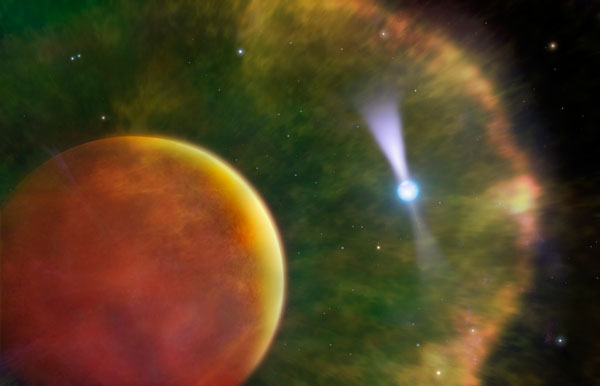Astronomers have discovered a pulsar that comes with its own magnifying glass — courtesy of its brown dwarf companion that’s being torn to shreds.

Mark A. Garlick / Dunlap Institute for Astronomy & Astrophysics, Univ. of Toronto
In a system 6,500 light-years away, a pulsar and brown dwarf are dancing a cosmic dervish, whipping around each other every nine hours. Their dance won’t last — in addition to its lighthouse-like beam of radio waves, the pulsar PSR B1957+20 is giving off a fierce wind of particles that’s slowly blasting away its companion. For this reason, the pulsar has earned the name “black widow,” after the species of spider that eats its mate.
But before the meal is complete, the brown dwarf has something to offer us: a magnifying glass that exposes the pulsar in incredible detail.
The entire system is tiny: The brown dwarf is the size of Jupiter and the pulsar is only the size of Manhattan; the distance that separates them is roughly five times the distance between Earth and the Moon. From Earth’s point of view, the brown dwarf is big enough to eclipse the pulsar for 40 minutes every time they circle each other.
It’s this fortunate geometry that gives the brown dwarf its magnifying power. If you’ve ever admired the beautiful patterns of light along a shoreline, you’ve watched light bend as it passes through water. Waves in the water concentrate sunlight to create those wiggling patterns on the sand. The cocoon of plasma around the brown dwarf has a similar effect on the pulsar’s lighthouse beam — when everything lines up just right, we see the pulse of radio waves pass through the plasma, which concentrates the radiation.

It wasn’t obvious that this should happen. But in 2014 Robert Main (University of Toronto) and colleagues observed a full 9.2-hour orbit using the 305-meter William E. Gordon Telescope at Arecibo Observatory. Just before and just after every pulsar eclipse, they saw the radio pulses brighten. Moreover, the pulses brightened in different ways at different frequencies, exactly as expected for a lensing event.
“The other spectacular thing that happens,” Main explains, “is that the emission from the two poles of the pulsar is not amplified equally. There are times when the emission from one pole is greatly boosted, while the other is unaffected.”
In other words, the gaseous “lens” around the brown dwarf was sometimes magnifying emission from the pulsar’s north pole and sometimes its south pole — resolving two areas of emission only 10 km (6 miles) apart from 6,500 light-years away. That’s equivalent to resolving a flea on the surface of Pluto using Earth-based telescopes. (For reference, New Horizons flew right by Pluto and still only resolved features 80 meters, or 260 feet, wide!) The team has published their results in Nature.
As Jason Hessels (University of Amsterdam, The Netherlands) points out in an accompanying perspective piece, this isn’t the first time astronomers have seen plasma lensing. Other examples include distant quasars and the Crab Nebula pulsar. Yet it took 30 years between the discovery of PSR B1957+20 and the detection of its lensing. It comes down to the increase in computing power, Hessels argues, which has enabled astronomers to examine changes on microsecond scales over multiple radio frequencies. He concludes: “The future is bright for using pulsars to illuminate the invisible universe.”
 3
3









Comments
misha17
May 25, 2018 at 4:46 pm
Besides the analogy of the pulsar eating its companion, the image of the pulsar's 2 emission jets in the illustration look sort of like an hour-glass - and the female black widow spider has a red hour-glass marking in her abdomen!
You must be logged in to post a comment.
Rb7
May 25, 2018 at 5:17 pm
Thanks for a beautifully written article.
You must be logged in to post a comment.
Anthony Barreiro
May 25, 2018 at 6:33 pm
Right ascension 19 hours 57 minutes, declination 20 degrees North is in the constellation Sagitta, between Gamma Sagittae and the planetary nebula Messier 27. More broadly, it's in the Summer Triangle, between Altair in Aquila and Albireo in Cygnus. I know we're never going to see this pulsar and brown dwarf through an optical telescope, but I always like to know where things are in the sky.
You must be logged in to post a comment.
You must be logged in to post a comment.